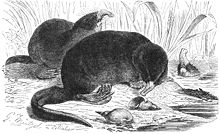

| Desmanini[1]
| |
|---|---|

| |
| Russian desman (Desmana moschata) | |
| Scientific classification | |
| Domain: | Eukaryota |
| Kingdom: | Animalia |
| Phylum: | Chordata |
| Class: | Mammalia |
| Order: | Eulipotyphla |
| Family: | Talpidae |
| Subfamily: | Talpinae |
| Tribe: | Desmanini Thomas, 1912 |

| |
Desmans are diving insectivores of the tribe Desmanini (also considered a subfamily, Desmaninae) in the mole family, Talpidae.
This tribe consists of two extant monotypic genera of semiaquatic insectivores found in Europe: one in Russia and the other in the northwest of the Iberian peninsula and Pyrenees. Both species are endangered, the Russian desman critically so.[2][3] They have webbed paws and their front paws are not well-adapted for digging. Desmans were much more diverse and widespread during the Miocene, with two genera, Gaillardia and Magnatalpa, being present in North America.[4][5] Both living species are thought to have derived from the fossil genus Archaeodesmana.[6]
video report
| Desmanini |
|
|---|---|